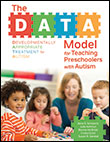How to use the DATA Model to help preschool students with autism thrive
School-based approach blends the benefits of inclusive education and intensive intervention
Two things we know work when it comes to the learning of young children with autism spectrum disorder:
- Children with ASD benefit from frequent, sustained interaction with typically developing peers.
- Children with ASD benefit from specialized and intensive instruction designed to address the primary deficit areas of ASD.
A newly published model combines these elements into one integrated school-based approach. The DATA Model (“developmentally appropriate treatment for autism”) is implemented on an ongoing basis during the school year and is designed to help school districts meet the needs of young children with ASD and their families.
Blending best practices from early childhood special education and applied behavior analysis (ABA), the DATA Model is rooted in evidence-based practice (developed under grant as “Project DATA”) and based on 20 years of testing and refinement.
With the DATA Model, children spend 20 hours per week in a school-based setting, with a minimum of 10 hours in an inclusive preschool setting and 10 hours in an intensive, instructional setting.
 One of two core beliefs: If a child is not progressing with the instruction he or she is receiving, instruction should be modified accordingly
One of two core beliefs: If a child is not progressing with the instruction he or she is receiving, instruction should be modified accordingly
The DATA Model for Teaching Preschoolers with Autism
 A new manual for implementing the comprehensive, school-based program for children ages 3 to 5 with autism spectrum disorder and their families
A new manual for implementing the comprehensive, school-based program for children ages 3 to 5 with autism spectrum disorder and their families
Learn more in The DATA Model for Teaching Preschoolers with Autism.
Two core beliefs
Developed by Dr. Ilene Schwartz and colleagues, the DATA Model is based on two core beliefs:
Children with ASD are children first
Children with ASD benefit from and are entitled to the same opportunities for play and learning that typically developing children receive.
Student failure is instructional failure
If a child is not progressing with the instruction he or she is receiving, instruction should be modified accordingly.
The DATA Model views every child as an individual and recognizes that while the use of evidence-based strategies are essential, children’s individual interests, learning styles, developmental levels, and progress must guide instruction.
With these core beliefs in mind, The Data Model comprises five components:
Children participate in high-quality fully inclusive preschool with regular, ongoing opportunities for interaction with typically developing peers.
Children receive between 20–25 hours of instruction—half in the inclusive classroom and half in a one-on-one or small-group instructional setting.
This model includes parent education, meetings, home visits, center visits, and help with school transition.
Teachers receive training and guidance in working productively with all providers.
Children learn skills to be more independent, to be more successful in inclusive school and community settings, and to interact more successfully with their families and friends.
How it works
When new students enter the class, teachers administer The DATA Model Skills Checklist.
This tool assesses children’s adaptive, cognitive, communication, social, and play skills. On the basis of the results of the checklist, teachers develop appropriate goals and objectives to facilitate students’ learning. The DATA Model manual includes more than 140 instructional programming sheets and lesson plans to increase children’s developmental progress in the areas identified by the checklist. (See a sample DATA Model instructional programming sheet and lesson plan on “following directions.”)
This linked system helps teachers pinpoint learning goals for children with ASD, promote their progress through tailored interventions, and support them in generalizing new skills and behaviors across settings.The Skills Checklist is administered at least twice a year to monitor progress and adjust instruction.
The manual provides detailed instruction and materials to help teachers
- design developmentally appropriate classrooms
- write lesson plans
- conduct assessments
- implement individualized instructional strategies
- address challenging behaviors
- create embedded learning opportunities (ELOs).
Embedded learning opportunities
Here is an example of how teachers can weave ELOs into instruction:
During a small group crafts activity, children are working on collages of different shapes. The teacher teaching the child with ASD a new vocabulary word holds up a diamond (a targeted vocabulary word) and says to the child, “What is this shape?” The child responds by pointing and saying “diamond.” The teacher uses a consequence/reinforcement strategy by saying, “You
are right. This is a yellow diamond,” and gives the child the shape for his collage.
The ELO takes place during an activity the child enjoys and is motivating for him. He wants to answer the question correctly so that he can continue with his collage. ELOs should take place throughout children’s days regardless of where they are and what they are doing. It’s important to understand that while ELOs may seem to happen naturally, in reality, teachers must be very intentional when it comes to planning them.
When a child answers incorrectly, the teacher should correct him or her in a neutral or matter-of-fact tone of voice. Dr. Schwartz, DATA Model lead developer, emphasizes how important it is to give feedback to children using positive reinforcement, which she calls the most powerful evidence-based strategy in the instructional toolbox. “It is important to use it frequently, correctly, and contingently to help children with ASD be as successful and independent as possible.”
Challenging behaviors
The DATA Model also emphasizes the importance of recognizing that challenging behavior is a means of communication. Typically, the child’s behavior is a way of communicating that he or she wants something or wants to avoid something. Teachers are coached to ask themselves, “What is the function of this behavior?” For instance, if a child throws a puzzle that the teacher has asked him to do many times, the child may be saying, “I’m bored with this puzzle. I do not want to do this puzzle.” If a child cries when a teacher walks away or attends to another child, the child may be saying, “Pay attention to me.”
After learning to interpret what is behind a child’s behavior, the teacher can then teach the child to use appropriate behaviors (words, symbols, or gestures) to obtain what they want or to modify things they don’t want.
The DATA Model provides detailed guidance on how to preempt challenging behaviors by
- following a well-designed classroom schedule
-
establishing clear classroom expectations and rules
- promoting positive child–teacher interactions
- providing contingent reinforcement for appropriate child behaviors
- creating a well-planned physical environment
- offering opportunities for children to make choices
***
After implementing the integrated approach of The DATA Model, teachers will see the fruits of their labor when they readminister the Skills Checklist and when they see how all of the children in their preschool class, including their students with ASD, thrive!
Originally published: February 2017
 A new manual for implementing the comprehensive, school-based program for children ages 3 to 5 with autism spectrum disorder and their families
A new manual for implementing the comprehensive, school-based program for children ages 3 to 5 with autism spectrum disorder and their families
 One of two core beliefs: If a child is not progressing with the instruction he or she is receiving, instruction should be modified accordingly
One of two core beliefs: If a child is not progressing with the instruction he or she is receiving, instruction should be modified accordingly